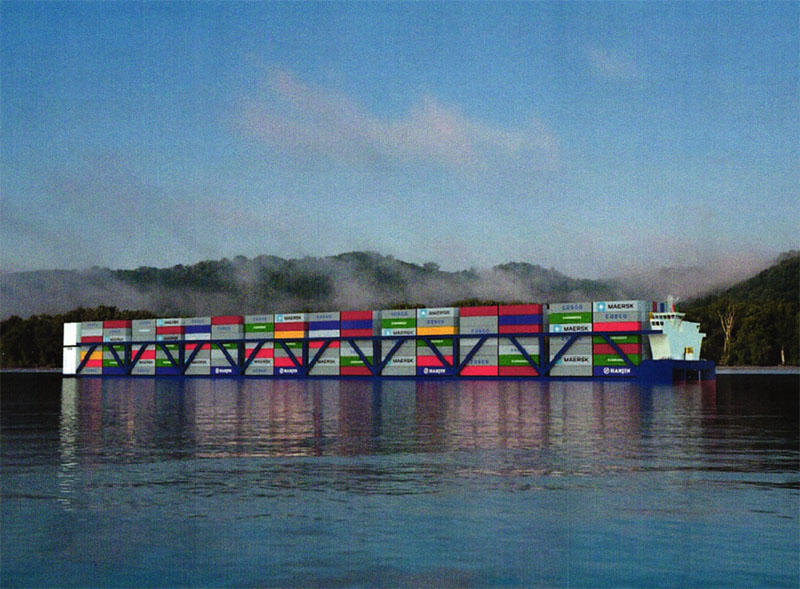Plaquemines Port Harbor & Terminal District (PPHTD) and American Patriot Holdings LLC (APH) announced plans yesterday to develop an intermodal container terminal on the lower Mississippi River, taking advantage of the port’s wide expanse of land and American Patriot Container Transport LLC’s (APCT) inland vessel design, able to efficiently deliver containers to and from ports on the Mississippi and Illinois Rivers. (APCT is a wholly owned subsidiary of APH.) It could be three to five years before the new container terminal is operational.
APH will use three different size container vessels with the company’s “Exoskeleton” hull design to haul containers on inland waterways. A total of four self-propelled container barges would be built once a terminal operator is located, but there could be as many as nine if full operational status is reached, according to a port spokesperson. APH has three vessel designs — 592'x100' (1,824 TEU), 772'x100' (2,392 TEU) and 952'x100' (2,960 TEU) — all with drafts of 9' in fresh water. APH, in conjunction with its naval architect, Naviform Consulting & Research Ltd., Vancouver, British Columbia, designed the vessels. The first vessel would take 18 to 24 months to complete and then subsequent vessels could come out of the shipyard in four month increments. No shipyard has been named.
Exoskeleton vessel hull structure is designed to maximize container payload, and the patented bow design enables the vessels to travel at 13 mph north and southbound with essentially no wake, APH officials said in a press release announcing the new operation. APH has exclusive rights for use of the design and an exclusive licensing agreement on the patents. APH believes the application of this technology will have worldwide appeal.
The propulsion system consists of four diesel generators, driving four azimuthing thrusters (Z-drives) and two bow pumps, burning LNG, the “cleanest fuel” for propulsion. Together, the main propulsion thrusters and the bow pumps eliminate the need for docking/undocking assist tugs, saving substantial time and expense. (None of the equipment manufacturers were announced in the prepared statement.)
Entering into an “Exclusivity Agreement” PPHTD and APH plan to jointly develop the logistics system for vessel operations comprised of both deepwater docking at the Pointe Céleste Container Terminal and multiple upriver terminals, initially planned for Memphis (seven days) and St. Louis (11 days).
PPHTD’s new container port, located between mile 50 and 55 on the Mississippi River, will be the southern-most full service port complex on the river, providing full intermodal service via river, rail, highway and air to and from the heartland of America. Users of the new terminal will realize economic efficiencies resulting from technological advances being built into the port, and operational safety advantages given the port’s geographic position, port officials said.
“We’re building a new, modern technology port from the ground up where berthing depths exceed 60 feet and with the capability to accommodate the larger Post-Panamax vessels coming through the widened and deepened Panama Canal,” said Sandy Sanders, executive director of Plaquemines Port, said in the prepared statement. “Containers imported to the Plaquemines Port would be transferred to APCT’s revolutionary vessels for delivery to their upriver port destination. Export containers will be efficiently delivered from upriver ports to the Plaquemines Port for export on ocean carriers. Beneficial cargo owners and ocean carriers alike should look at the planned port as a solution to their logistic problems and the high intermodal costs that plague them today. Cargo flows through the most efficient economical route and our plans are to provide shorter dwell times, lowest cost, with fast and reliable routes.”
Sal Litrico, CEO of American Patriot Container Transport LLC, said partnering with Plaquemines Port is very exciting, considering what will be offered to shippers. “Our team looks forward to meeting with shippers and ocean carriers to discuss their present day logistic and cost concerns, and how our system can be planned to optimize their business logistic efficiencies.”
The new port, comprised of 4,200 acres, will include a recently announced $8.5 billion LNG re-liquefaction facility, a break bulk terminal and a state-of-the-art container terminal expected to comprise approximately 1,000 acres. Designed to service the largest ocean carriers, the container terminal will be capable ofsafely docking vessels up to 20,000 TEU. Deepwater access and 21,600 linear feet of waterfront allow for multiple ocean and APCT vessels to be accommodated simultaneously.
“The Port has been working very hard on a diversity of projects which will amount to creating quality jobs and increasing the tax base for our parish,” said port chairman Beau Black.




